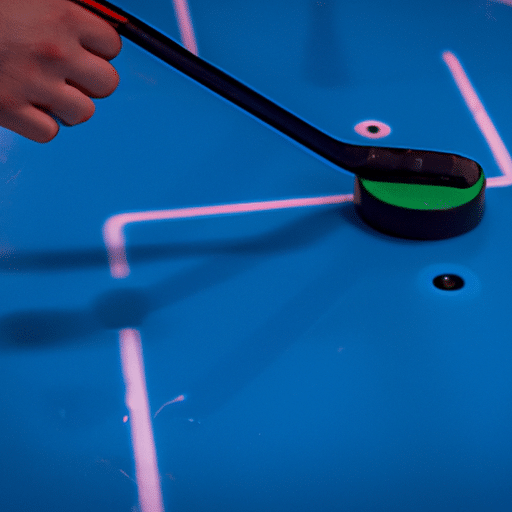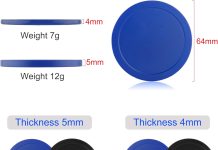Air hockey, the fast-paced tabletop game that brings out the competitive spirit in all of us. But have you ever wondered what exactly you’re playing towards in this thrilling game? Well, wonder no more! In this article, we will explore the objective of air hockey and reveal the ultimate goal that keeps players on the edge of their seats. So, get ready to slide and score as we uncover the answer to the age-old question, “What do you play to in air hockey?”
Review contents
Scoring in Air Hockey
Air hockey is a fast-paced and thrilling game that requires speed, accuracy, and strategy. Scoring goals is the ultimate objective in air hockey, and understanding the rules and techniques can greatly enhance our performance on the table. In this article, we will explore the various aspects of scoring in air hockey, including the basic rules, scoring targets, common strategies, defensive tactics, types of shots, the importance of speed and accuracy, advanced scoring techniques, professional scoring rules, scoring etiquette, and practice drills. So let’s dive in and discover the exciting world of air hockey scoring!
Basic Rules of Air Hockey
Before we delve into the intricacies of scoring in air hockey, let’s first understand the basic rules of the game. Air hockey is typically played on a smooth tabletop that features a low-friction surface and air jets that allow the puck to glide effortlessly. The table is divided into two halves, with each player defending their goal slot and aiming to score in their opponent’s goal. The game is played with two paddles, often called strikers, and a puck. The basic objective is to score more goals than the opponent by shooting the puck into their goal slot using the strikers. Now that we have the basics covered, let’s move on to the scoring system in air hockey.
Scoring System in Air Hockey
In air hockey, scoring involves shooting the puck into the opponent’s goal slot. Each time a player successfully shoots the puck into the goal, they score one point. The first player to reach a designated number of points, usually 7 or 10, wins the game. However, when the players are closely matched, they may play a timed game, with the winner being determined by the player who has the most points when the time runs out. Now that we understand the scoring system, let’s explore the scoring targets in air hockey.
Goals on Air Hockey Table
The air hockey table features two goals, one on each player’s side, which act as the primary scoring targets. These goals are rectangular slots located at the center of each end of the table. The objective is to shoot the puck into the opponent’s goal while defending our own goal. The dimensions of the goals may vary slightly depending on the table, but they are typically large enough to allow for swift puck movement and exciting scoring opportunities. Now that we know about the goals, let’s move on to understanding the goal slots in air hockey.
Goal Slots in Air Hockey Table
The goal slots in air hockey are the specific areas within the goal where the puck must pass through for a goal to be counted. These goal slots are narrower than the overall goal and are often equipped with sensors that detect when the puck enters the goal area. The sensors are connected to a scoring mechanism that automatically adds a point to the player who scored the goal. It is essential to aim accurately and hit the puck into these goal slots to successfully score a point. Now that we are familiar with the goal slots, let’s explore the target areas to score in air hockey.
Target Areas to Score in Air Hockey
While the goal slots are the primary target areas to score in air hockey, they are not the only areas where goals can be scored. Skilled players often utilize various target areas on the table to confuse their opponents and increase their chances of scoring. These target areas include the corners of the goal, the railings, and the gaps between the opponent’s striker and the goal slot. By strategically aiming at these target areas, players can surprise their opponents and achieve successful goals. Now that we understand the scoring targets, let’s explore some common scoring strategies in air hockey.
Common Scoring Strategies
To become proficient at scoring in air hockey, it is essential to have a repertoire of effective scoring strategies. Let’s delve into some common scoring strategies that players often utilize on the table.
Corner Shots
Corner shots involve aiming the puck towards the corners of the opponent’s goal. By shooting the puck into the corners, players can create challenging angles for their opponents to defend and improve their chances of scoring. Corner shots require accuracy and precision to navigate the puck around the opponent’s striker and into the goal slot.
Bank Shots
Bank shots involve bouncing the puck off the table’s walls or the opponent’s striker to create unexpected trajectories and confuse the opponent. By skillfully angling the puck, players can direct it towards the goal, taking advantage of the rebound effect. Bank shots require quick reflexes and the ability to predict the puck’s trajectory.
Fast Shots
Fast shots focus on using speed to catch the opponent off-guard and make it difficult for them to react in time. By swiftly shooting the puck towards the goal, players can surprise their opponents and score before they can effectively defend their goal. Fast shots require a combination of speed, accuracy, and agility.
Powerful Shots
Powerful shots involve applying greater force to the puck, making it harder for the opponent to block or intercept the shot. By generating more power behind the shot, players can increase the speed and intensity of the puck, increasing the likelihood of scoring. Powerful shots require strength, technique, and precision.
By incorporating these scoring strategies into our gameplay, we can elevate our performance and increase our chances of scoring goals. However, scoring is not the only aspect of air hockey; we must also employ defensive tactics to prevent our opponents from scoring.
Defensive Tactics to Prevent Scoring
To become a well-rounded air hockey player, it is crucial to have a robust defense game. Defensive tactics can prevent opponents from scoring goals and give us an advantage on the table. Let’s explore some effective defensive strategies in air hockey.
Blocking Shots
Blocking shots involves positioning our striker between the opponent’s puck and our goal slot to intercept and deflect incoming shots. By predicting the opponent’s moves and reacting swiftly, we can block their shots and frustrate their attempts to score. Strategic positioning, quick reflexes, and precise movements are essential for effective shot blocking.
Intercepting the Puck
Intercepting the puck requires anticipating the opponent’s passes and shots to intercept the puck before it reaches our goal. By reading the opponent’s movements and positioning ourselves strategically, we can intercept the puck, preventing them from scoring and gaining control of the game. Intercepting the puck requires excellent observation, anticipation, and agile movements.
Using the Rail
Using the rail refers to utilizing the edges of the table as an additional defensive tool. By hugging the rail with our striker, we create a barrier that limits the available shooting angles for the opponent. This defensive tactic makes it more challenging for the opponent to score by restricting their options and forcing them to make riskier shots. Skillful rail usage requires precise positioning, coordination, and control.
By incorporating these defensive tactics into our gameplay, we can effectively prevent our opponents from scoring and maintain control of the game. However, scoring in air hockey is not solely dependent on defensive skills; our shot techniques also play a vital role.
Types of Shots
In air hockey, the types of shots we employ can greatly impact our scoring potential. Let’s explore some common types of shots that players often utilize:
Forehand Shots
Forehand shots involve shooting the puck by striking it with the front side of the striker. This is the most common shooting technique and offers a balance of power, accuracy, and control. Forehand shots are versatile and can be used in various situations, giving players a reliable tool to score goals.
Backhand Shots
Backhand shots involve shooting the puck by striking it with the backside of the striker. This technique offers players the advantage of surprise and unpredictability, as the opponent may not anticipate a shot from this angle. Backhand shots require precision and finesse to generate enough force and accuracy.
Slap Shots
Slap shots involve using a quick, forceful motion to strike the puck, generating significant power and speed. This shooting technique is commonly used when there is a need for a fast and powerful shot, often from a distance. Slap shots require a combination of strength, timing, and technique.
Wrist Shots
Wrist shots involve flicking the wrist while striking the puck, allowing for quick and controlled shots. This shooting technique offers players the advantage of speed and accuracy, as the flicking motion generates a swift release. Wrist shots require precise timing, coordination, and finesse.
By mastering these different types of shots, we can adapt to various game situations and increase our chances of scoring goals. However, scoring in air hockey is not solely dependent on shot techniques; it also requires a focus on speed and accuracy.
The Importance of Speed and Accuracy
Speed and accuracy are two crucial components of successful scoring in air hockey. Let’s explore how we can improve speed and enhance shot accuracy to become more effective on the table.
Improving Speed in Air Hockey
Improving speed in air hockey is essential to catch opponents off-guard and create scoring opportunities. One way to enhance speed is by practicing quick and agile movements. Regularly engaging in speed-focused drills can improve our reflexes, agility, and overall gameplay. Additionally, maintaining a good fitness level can contribute to our speed and endurance, allowing us to sustain our performance throughout the game.
Enhancing Shot Accuracy
Shot accuracy is crucial for successfully hitting the scoring targets and avoiding the opponent’s striker. To enhance shot accuracy, we can practice targeting specific areas on the table and aim for consistency. Developing muscle memory through repetitive practice can significantly improve shot accuracy. Additionally, focusing on our grip, posture, and hand-eye coordination can contribute to better accuracy.
By incorporating both speed and accuracy into our gameplay, we can become formidable opponents on the air hockey table. However, as we progress in our skills, it’s important to explore more advanced scoring techniques.
Advanced Scoring Techniques
Advanced scoring techniques can take our air hockey game to the next level. Let’s explore some of these techniques:
Combination Shots
Combination shots involve combining different shooting techniques and strategies to create unpredictable and challenging shots for the opponent. These shots require creativity, flexibility, and the ability to quickly adapt to changing game circumstances. By mastering combination shots, we can surprise our opponents and score goals that are difficult to defend against.
Offensive Strategies
Offensive strategies involve studying opponents’ weaknesses and adapting our gameplay to exploit those weaknesses. This could involve targeting specific areas on the table that are difficult for the opponent to defend, utilizing their blockers as targets for bank shots, or consistently pressuring the opponent’s goal with fast-paced attacks. By employing offensive strategies, we can keep the opponent on their toes, making it easier for us to score goals.
Psychological Mind Games
Psychological mind games involve using tactics to create distractions and disrupt the opponent’s focus. This could include intentional body language cues, strategic trash-talking, or deceptive movements to create confusion. By playing psychological mind games, we can provoke errors in the opponent’s gameplay and gain an advantage.
By incorporating these advanced scoring techniques into our gameplay, we can surprise our opponents with our creativity and versatility. However, it’s important to remember that air hockey is not just about individual skills; it also has specific rules in professional tournament play.
Professional Air Hockey Scoring Rules
In professional air hockey tournaments, specific rules govern scoring, ensuring a fair and competitive environment. Let’s explore some of these rules:
Rules in Tournament Play
In professional tournament play, scoring rules may vary slightly, but the core objective remains the same: score more goals than the opponent. Tournament matches are generally played to a predetermined number of points, often ranging from 7 to 10, and the first player to reach or surpass that number wins the match. In some cases, timed games may be played, where the player with the most points at the end of the designated time period is declared the winner.
Scoring Disputes and Resolutions
Scoring disputes may occasionally arise during tournaments, and there are established procedures to resolve them. These procedures vary depending on the tournament and its specific rules. Typically, an appointed official or referee reviews the disputed scoring situation, analyzes any available video footage or other evidence, and makes a judgment based on the rules. It’s important for players to abide by the decisions made by officials and maintain good sportsmanship, even in the face of disagreements.
Following the professional scoring rules ensures fair play and maintains the integrity of the game. However, it’s not just professional play that demands good sportsmanship; scoring etiquette should be practiced by all players, regardless of skill level or setting.
Scoring Etiquette
Scoring etiquette is an important aspect of air hockey, promoting respect, fair play, and a positive playing atmosphere. Let’s explore some essential aspects of scoring etiquette:
Respectful Celebrations
When scoring a goal, it is crucial to celebrate respectfully to maintain good sportsmanship. Excessive taunting or gloating can be disrespectful to the opponent and negatively impact the overall enjoyment of the game. Simple gestures such as raising our hands or giving a nod of acknowledgment are more appropriate ways to celebrate a goal while maintaining a friendly atmosphere.
Dealing with Losing
Losing gracefully is an essential part of any competitive game, including air hockey. It’s important to understand that losing is a natural part of the game and should be viewed as an opportunity to learn and improve. Congratulating the opponent and acknowledging their skill and achievement demonstrates good sportsmanship and fosters a positive playing environment.
Sportsmanship in Air Hockey
Sportsmanship is at the core of air hockey. It encompasses fairness, respect for opponents, and playing with integrity. Displaying good sportsmanship involves accepting victories and defeats with grace, treating opponents with respect, adhering to the rules, and displaying courtesy at all times. By practicing good sportsmanship, air hockey becomes not only a game but a positive social experience for all participants.
As we continue to develop our skills and knowledge of scoring in air hockey, it’s crucial to engage in regular practice to refine our techniques.
Practice Drills for Scoring
To improve our scoring abilities, we can incorporate various practice drills into our training routine. Let’s explore some solo and partner practice drills:
Solo Practice Drills
Solo practice drills allow us to focus on our individual skills and work on specific aspects of scoring. Some solo practice drills include practicing different shot techniques, targeting specific areas on the table, improving speed and accuracy, and practicing defense against virtual opponents using replay systems or simulation tools. By investing time in solo drills, we can fine-tune our skills and develop consistency in scoring.
Partner Practice Drills
Partner practice drills involve engaging in cooperative or competitive exercises with a fellow player. These drills simulate real-game scenarios and improve our ability to adapt to different playing styles. Partner practice drills can include timed scoring competitions, rally drills, mock game simulations, and targeted practice of defensive and offensive strategies. By practicing with a partner, we can gain valuable insights, challenge ourselves, and refine our scoring techniques in a more dynamic setting.
By incorporating these practice drills into our training routine, we can accelerate our progress and become more proficient in scoring in air hockey.
In conclusion, scoring in air hockey requires a combination of skill, strategy, and sportsmanship. Understanding the basic rules, realizing the various scoring targets, implementing effective strategies, employing defensive tactics, utilizing different shot techniques, focusing on speed and accuracy, exploring advanced scoring techniques, abiding by professional scoring rules, exhibiting scoring etiquette, and incorporating practice drills into our training all contribute to our success on the air hockey table. So let’s embrace the excitement of this exhilarating sport, strive to improve our skills, and enjoy the joy of scoring goals in air hockey!























![Best Outdoor Dartboards [Reviews and Buying Guide 2024] Best Outdoor Dartboards](https://gamersets.com/wp-content/uploads/2022/12/Best-Outdoor-Dartboards-100x70.jpg)

![Best Mini Air Hockey Table [Reviews & Buying Guide 2024] Best mini air hockey table](https://gamersets.com/wp-content/uploads/2022/10/Best-mini-air-hockey-table-100x70.jpg)







